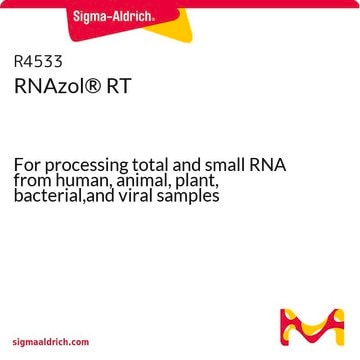R2020
RNaseZAP™
Cleaning agent for removing RNase
Synonym(s):
RNAse cleaner, RNAse contamination remover, RNAse remover
About This Item
Recommended Products
form
liquid
feature
RNase free (removal from glass and plastic surfaces)
packaging
pkg of 250 mL
technique(s)
RNA purification: suitable
pH
7.0-7.4
transition temp
flash point 100 °C (closed cup)
solubility
water: soluble
density
1000 g/cm3
Related Categories
General description
Application
- RNaseZAP™ has been used as a cleaning agent for removing RNase from glassware, apparatus, countertops and pipettors.
- Remove RNase contamination from glass and plastic surfaces
- CAUTION: Please note that RNaseZap Solution should not be used on corrodible metal surfaces
Legal Information
Storage Class
12 - Non Combustible Liquids
wgk_germany
WGK 2
flash_point_f
Not applicable
flash_point_c
Not applicable
Choose from one of the most recent versions:
Certificates of Analysis (COA)
Don't see the Right Version?
If you require a particular version, you can look up a specific certificate by the Lot or Batch number.
Already Own This Product?
Find documentation for the products that you have recently purchased in the Document Library.
Customers Also Viewed
Articles
Learn how water impurities can affect DNA and RNA electrophoresis and blotting. High purity water purified using ultrafiltration is suitable for nucleic acid electrophoresis, Northern and Southern blotting.
SeqPlex™-I WTA kit amplifies RNA for NGS, enabling genomic studies from limited samples.
Related Content
KOD One™ PCR Master Mix overview for ultra-fast PCR with high specificity, fidelity, and yield
Our team of scientists has experience in all areas of research including Life Science, Material Science, Chemical Synthesis, Chromatography, Analytical and many others.
Contact Technical Service











